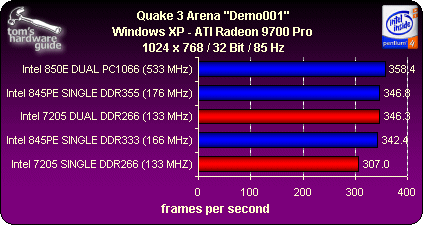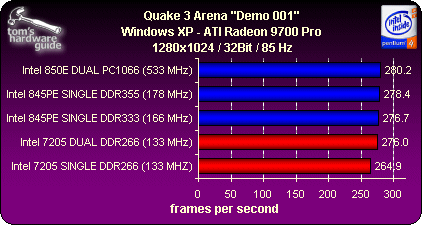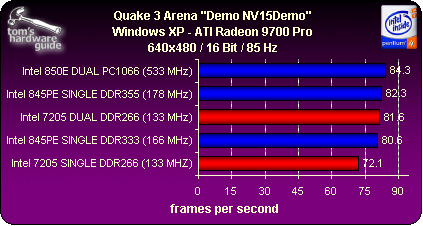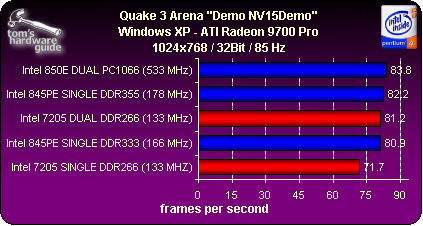Dual DDR For Pentium 4: Intel E7205 Chipset Put To The Test
Benchmarks In Windows 2000
As all test candidates are still in the beta testing stage, we will run the benchmarks on the Gigabyte GA-8INXP as an example. This board mastered all benchmarks at the drop of a hat with reasonable performance character, while the competitors had noticeable instabilities from time to time. We would like to state expressly at this point that no verdict can be handed down on the competitors while they are in the current stage. This will only be possible when the final versions appear. This preview focuses more on features and less on performance differences between the individual test candidates! The Tyan Tiger i7500 S2722 dual Xeon board is not put to a performance test, merely introduced.
In the current performance benchmarks, we are comparing the i845PE (single-channel DDR333 SDRAM), the E7205 and the i850 (dual-channel RDRAM PC1066). In addition, the special "DDR355" configuration in the Asus P4PE is used. We will also be comparing the performance differences between the single- and dual-channel configuration on the E7205. First, a general statement: the average difference is between 15 percent and 20 percent. Only in the questionable SiSoft Sandra test did we discover 60-percent differences.
We are using different benchmarking tests to present a multi-faceted and balanced picture of the performance of the Intel E7205 chipset. We will determine OpenGL performance with four different Quake III Arena tests. The various MPEG encoding benchmarks make for a comprehensive testing scenario: using the Lame MP3 encoder and an mp3 Maker platinum, a 178 MB WAV file is coded in "MPEG-1 layer 3 format." Our MPEG-4 test is within the established standard in which a file is converted from a commercial DVD-ROM into an MPEG-4 format using Flask 0.7 and Divx-Codec 5.02. Calculating the rendering performance using Cinema 4D XL 7,303 is part of the standard repertoire. Packing files, which we will do with the new WinACE-Packer 2.1, also has practical applications. To measure CPU and multimedia performance, we are using the PC Mark 2002 benchmark. The new SPECviewperf benchmark in Version 7 offers a comprehensive 3D benchmark. 3D game performance is tested in DirectX 8 using 3D Mark 2001 and Comanche 4. Also worthy of mention is the SiSoft Sandra Pro 2002 synthetic benchmark.
OpenGL-Performance: Quake 3 Arena
Get Tom's Hardware's best news and in-depth reviews, straight to your inbox.
Current page: Benchmarks In Windows 2000
Prev Page Test Setup Next Page DirectX 8 Games: 3D Mark 2001 SE




